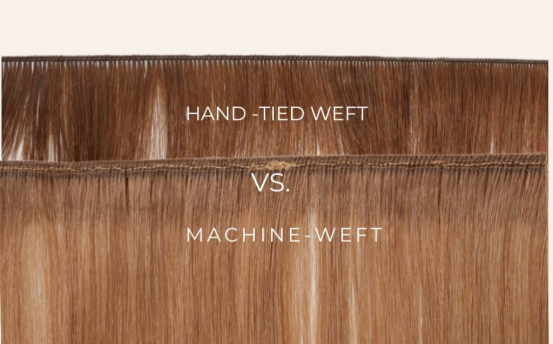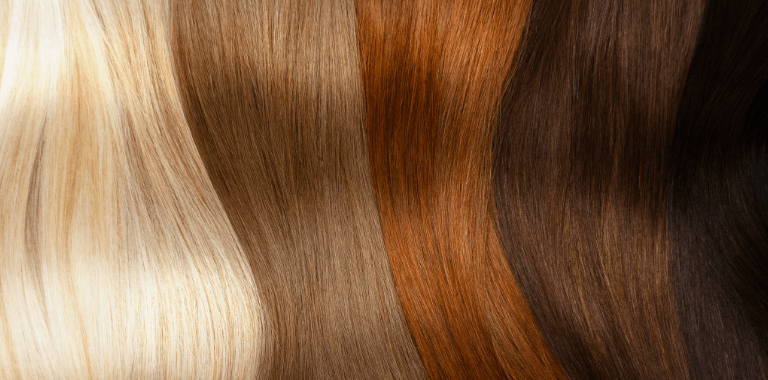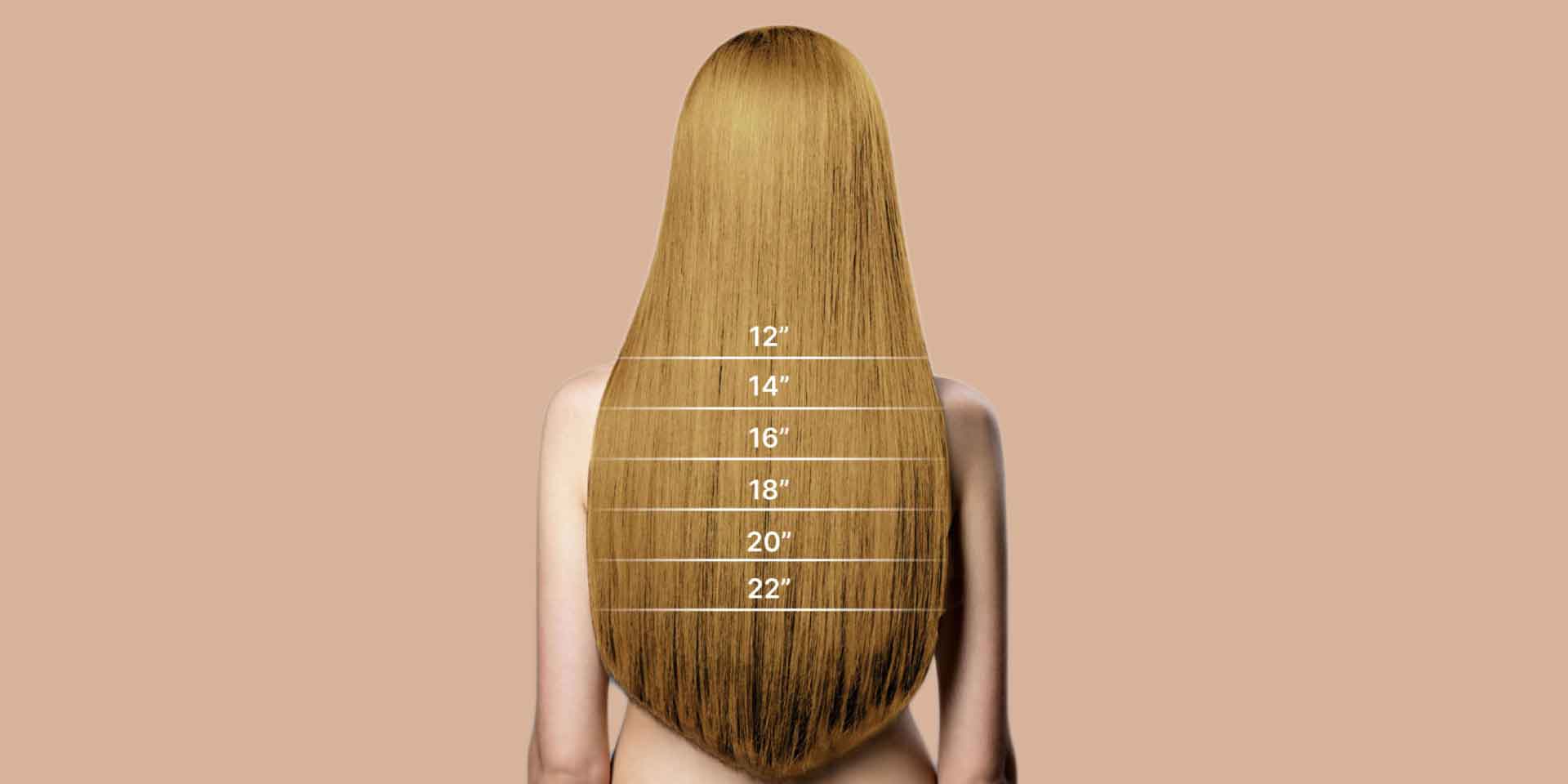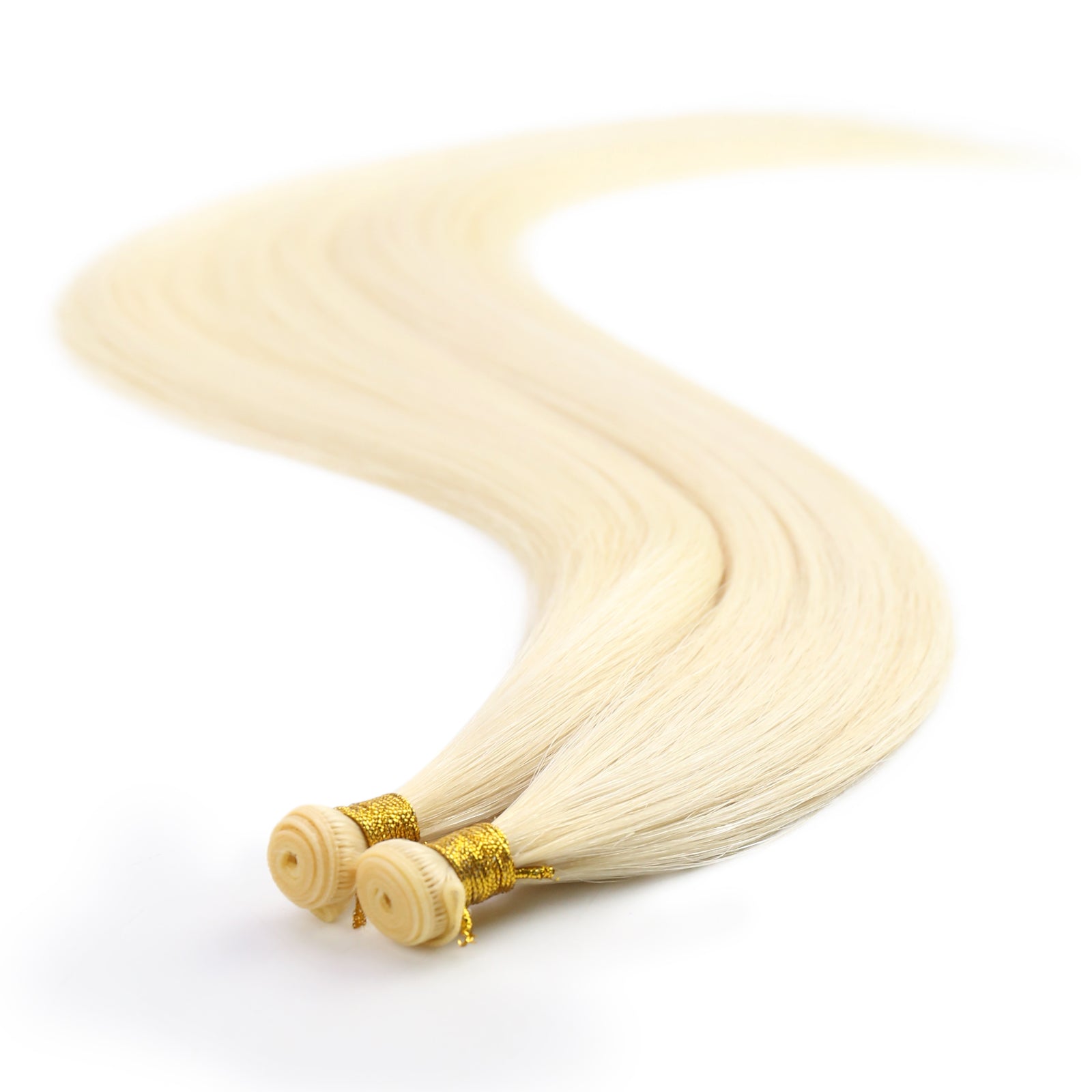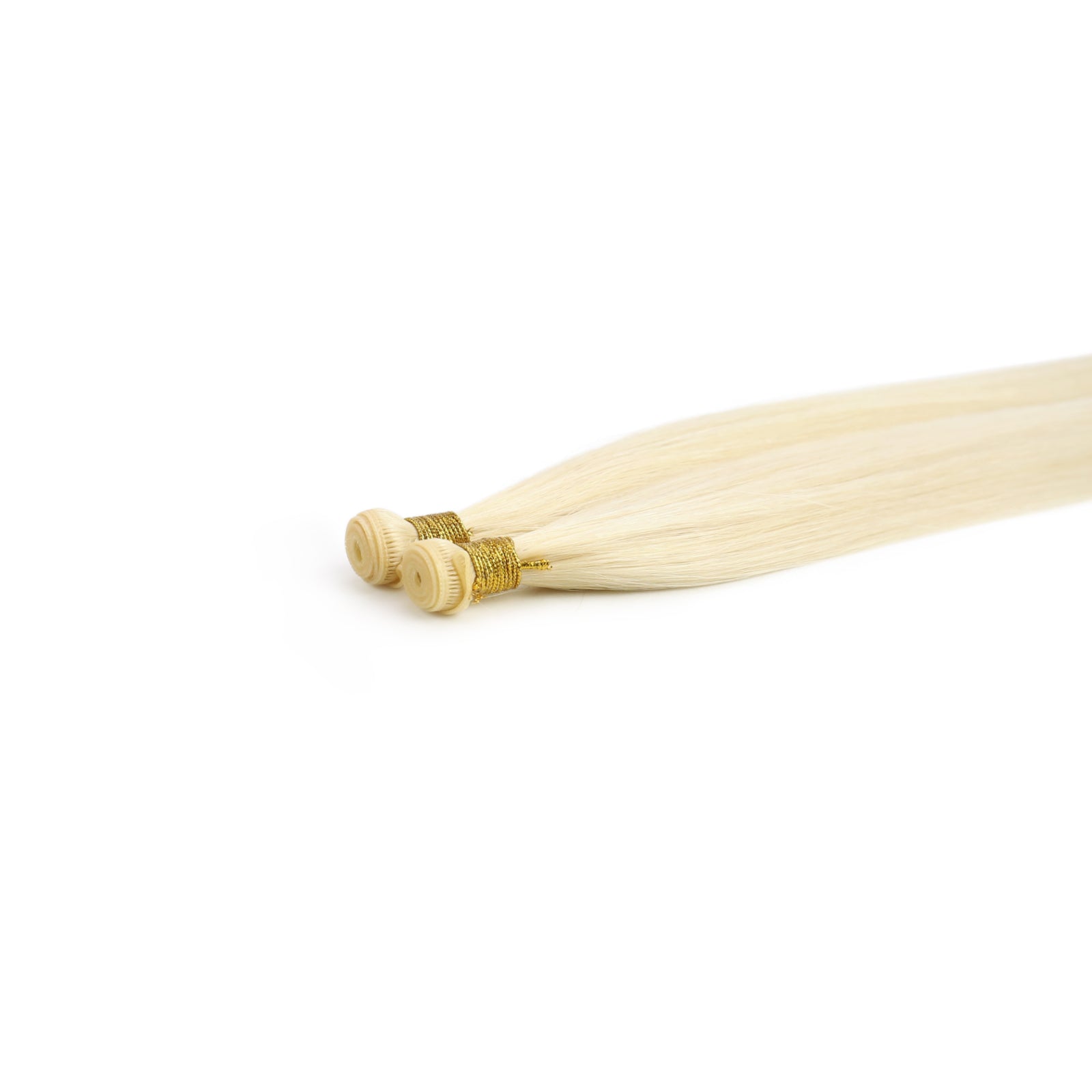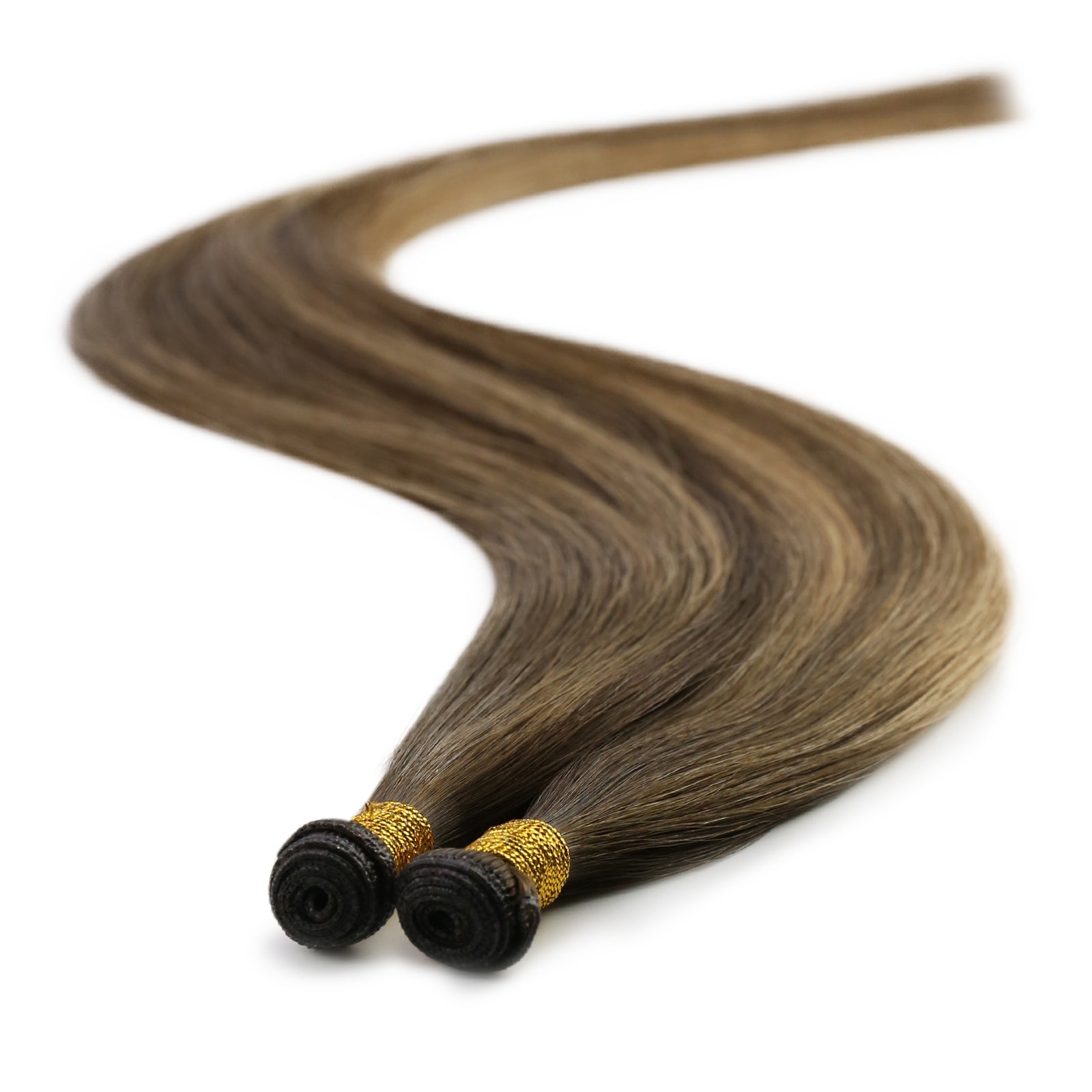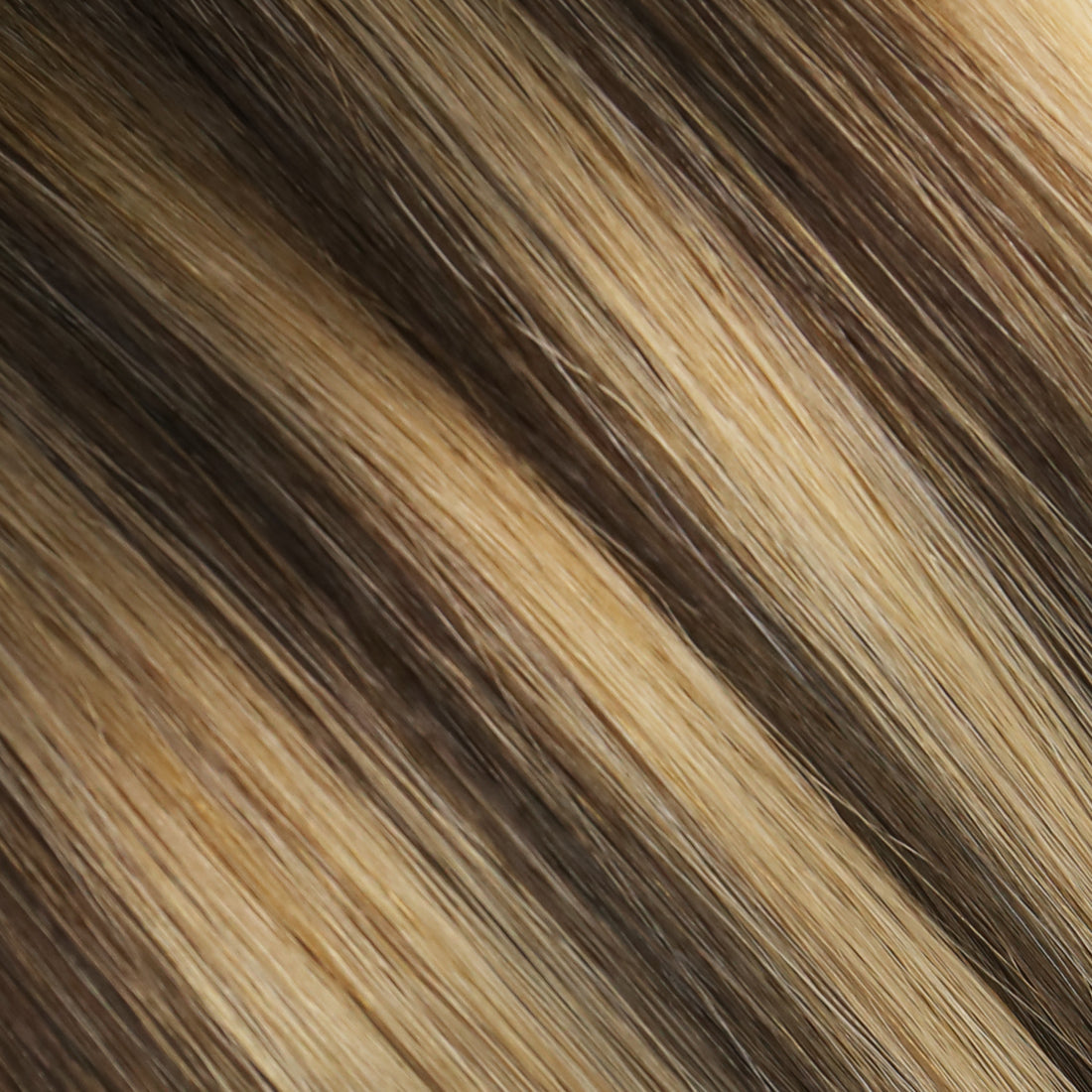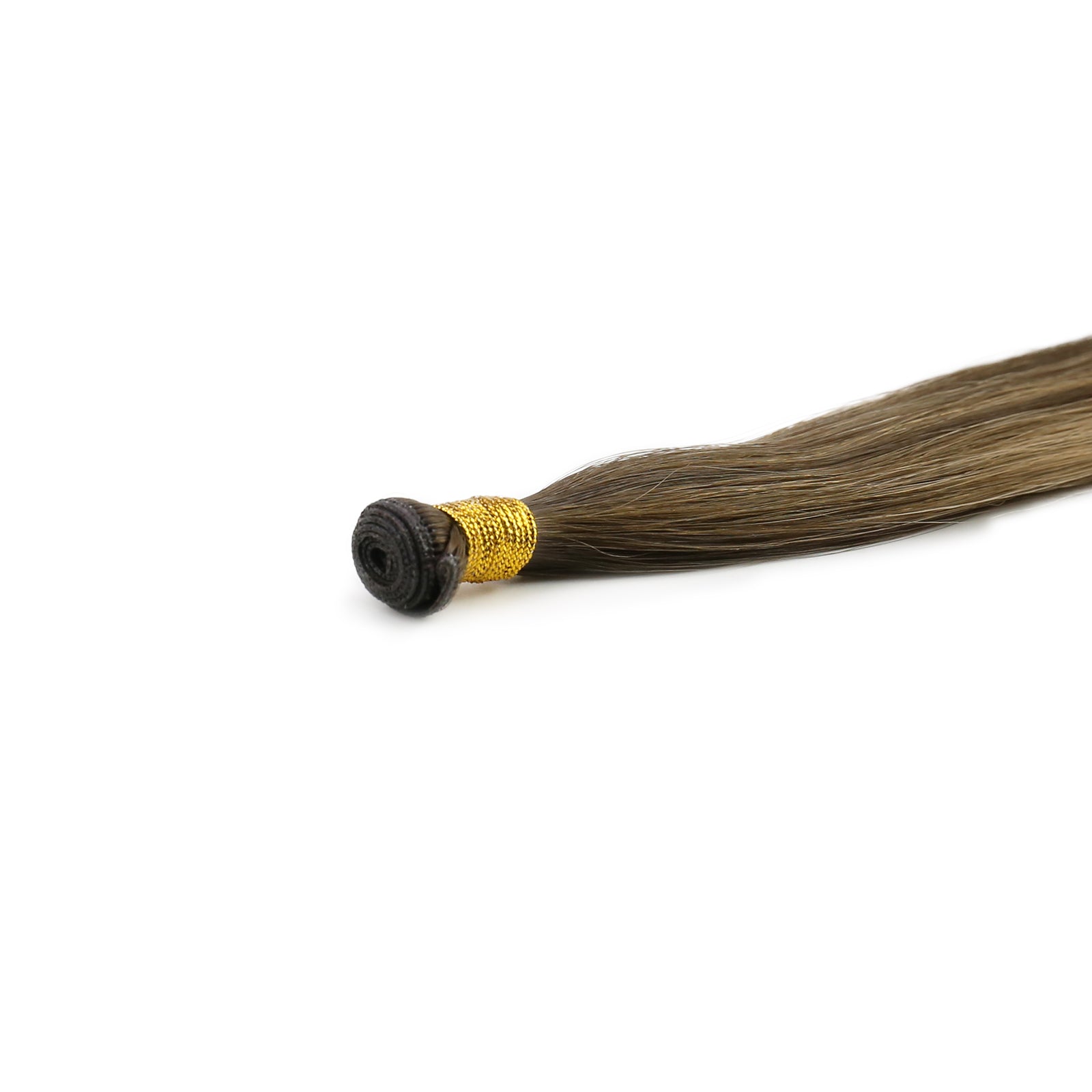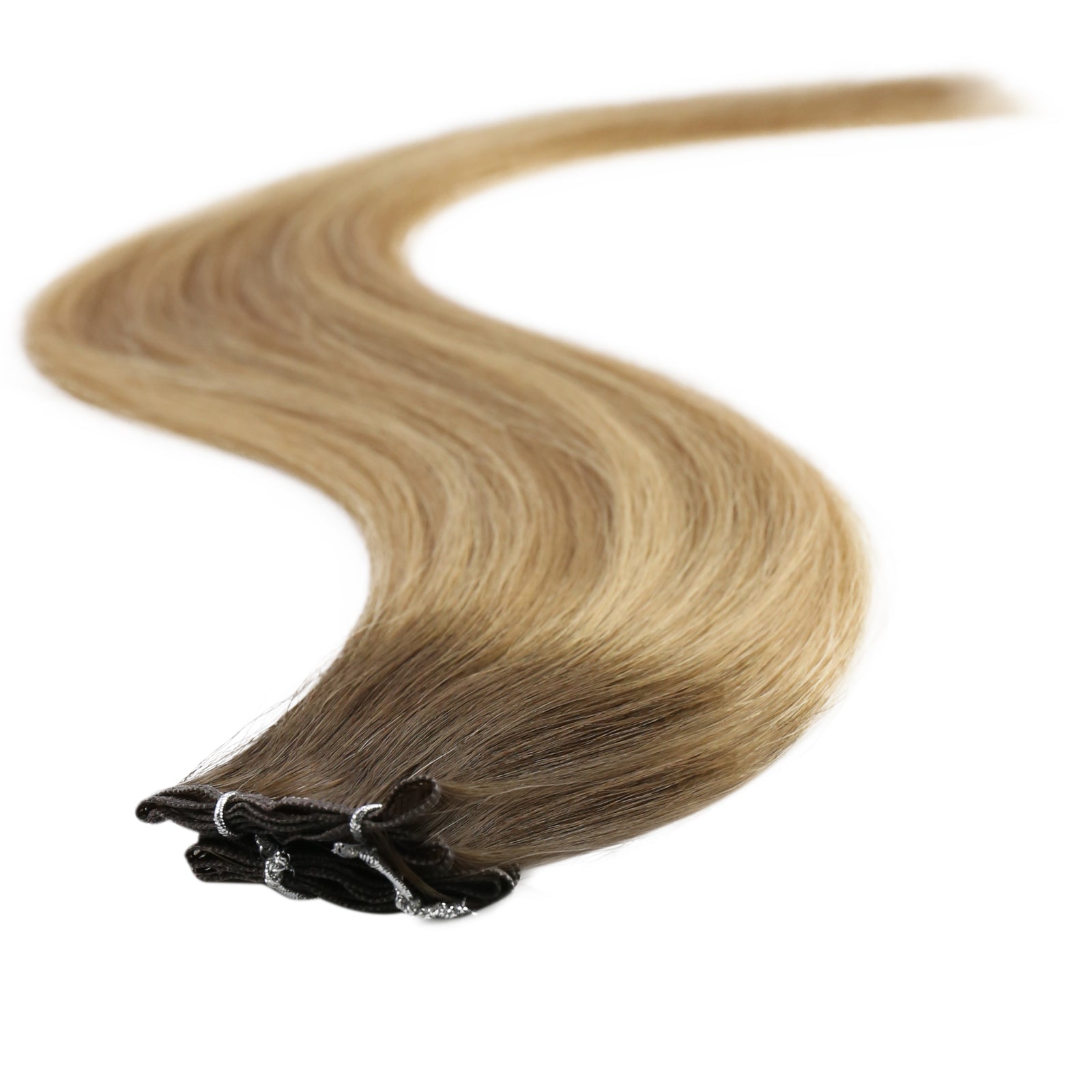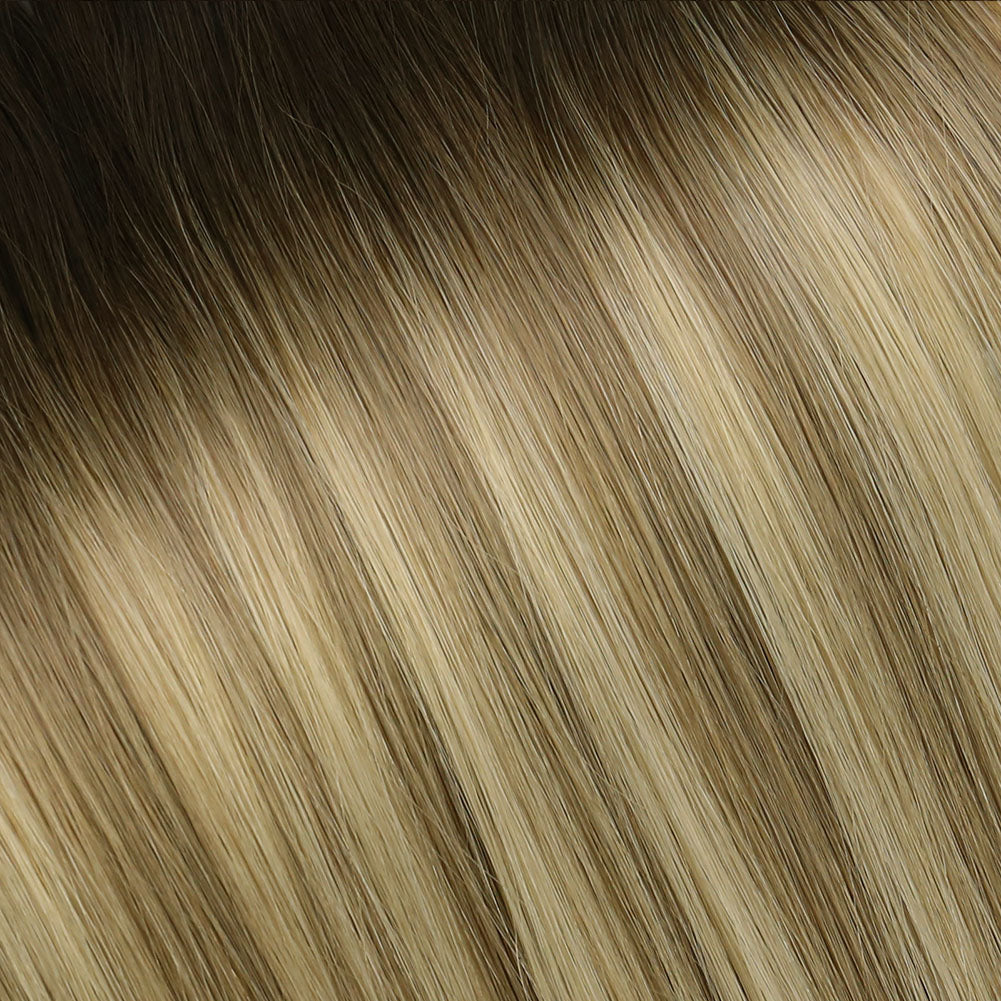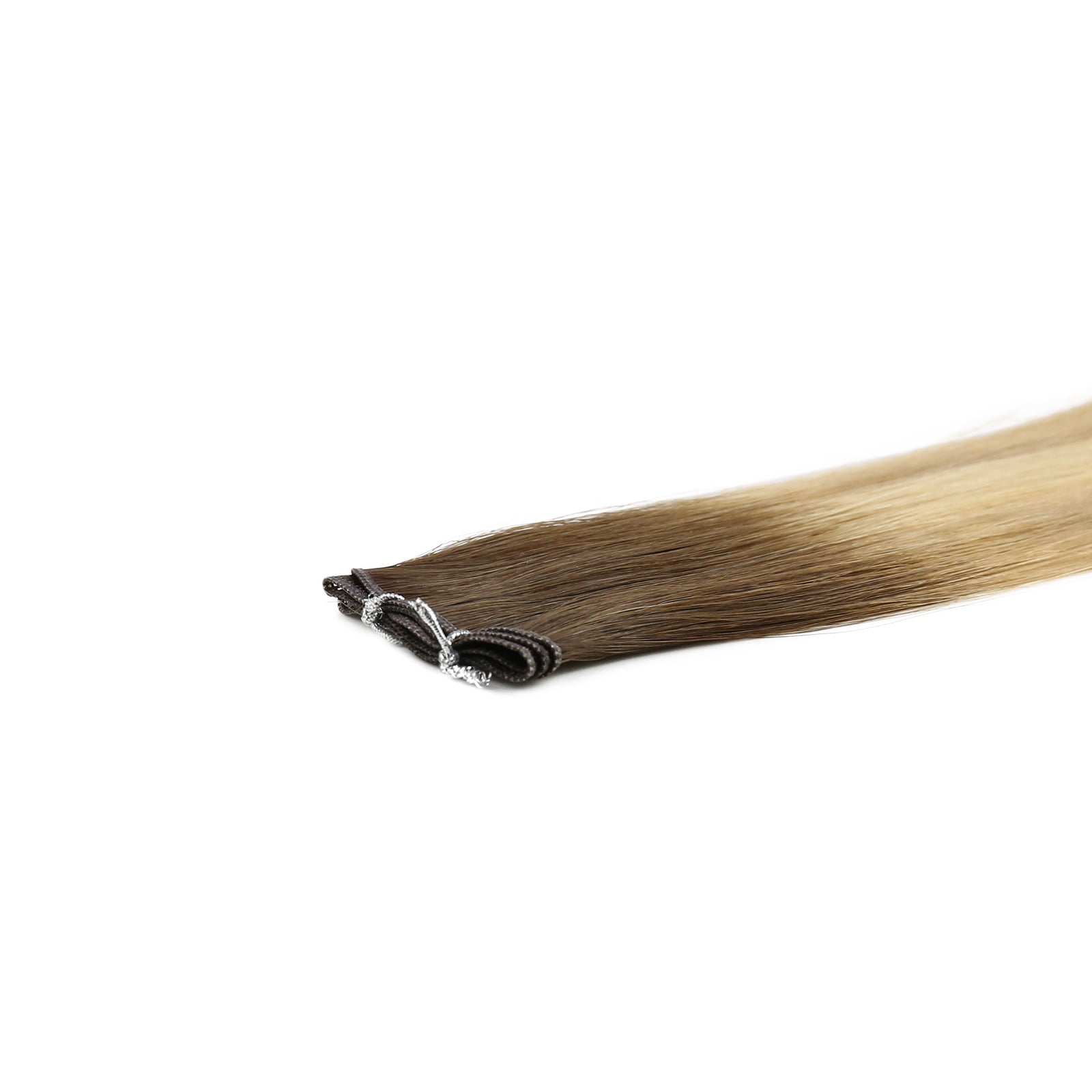Hair extensions have revolutionized personal styling, offering transformative possibilities for length, volume, and confidence. Among the myriad options, hand-tied and machine weft extensions stand out for their distinct qualities.
This blog aims to dissect and compare hand-tied vs machine weft hair extension. Whether you're navigating hair loss or seeking a style refresh, understanding these differences is key to choosing extensions that align with your lifestyle and aesthetic desires.

Overview of weft hair extensions
Weft hair extensions, comprising synthetic or natural strands attached to form a weft, seamlessly enhance hair length, volume, and color. As a durable sew-in option, both hand-tied and machine wefts offer a semi-permanent solution, lasting weeks to months with proper care, making them a popular choice for transformative hair styling.
What are Hand-Tied Wefts?
Hand-tied wefts are artisanal hair extensions where each strand of hair is meticulously tied by hand to a thin thread. This labor-intensive process produces wefts that are significantly thinner and more delicate than their machine-made counterparts, ensuring a fit that is both seamless and nearly invisible to the eye.
Benefits of Hand-Tied Wefts
- Natural Appearance: Their fine construction allows these wefts to blend seamlessly with your natural hair, offering a look that is both beautiful and undetectable.
- Flexibility in Styling: The thinness and lightness of hand-tied wefts provide unparalleled versatility, enabling a wide range of hairstyles without the worry of visible wefts.
- Comfort and Lightweight:Due to their delicate nature, hand-tied wefts are exceptionally comfortable to wear, often feeling like a natural extension of your own hair.

Potential Drawbacks
- Higher Cost: The detailed craftsmanship required to produce hand-tied wefts results in a higher price point compared to machine wefts.
- Longer Installation Time:The installation process for hand-tied wefts is more intricate and time-consuming, necessitating a skilled stylist and longer salon visits.
- Maintenance Requirements:Hand-tied wefts demand gentle care and regular maintenance to preserve their appearance and longevity, which might be a consideration for those looking for low-maintenance solutions.
Hand-tied wefts stand at the forefront of hair extension innovation, delivering unparalleled natural looks, versatile styling, and unmatched comfort. Yet, it's essential to weigh their premium price, extended installation duration, and upkeep requirements against your personal hair enhancement goals to determine if they truly meet your needs.
What are Machine Wefts?
Machine wefts are hair extensions produced using advanced machinery that sews strands of hair together to create a weft. This process is highly efficient, allowing for mass production of hair extensions. Machine wefts are characterized by their uniformity and strength, making them a popular choice for those seeking durable and reliable hair enhancements.
Benefits of Machine Wefts
- Durability and Strength:The mechanized sewing process creates a robust weft that can withstand significant wear and tear, making these extensions ideal for long-term use.
- Cost-Effectiveness: Thanks to the efficiency of their production, machine wefts are generally more affordable than hand-tied options, offering a budget-friendly solution for hair extension seekers.
- Easier to Install: The structured nature of machine wefts makes them simpler and quicker to install, potentially reducing the time spent in the stylist's chair.
Potential Drawbacks
- Heavier and Might Feel Less Comfortable:Machine wefts tend to be thicker and heavier than hand-tied wefts, which may result in a less comfortable fit for some individuals, especially those with fine or sensitive scalps.
- Less Natural Appearance in Certain Styles:While machine wefts can blend well with natural hair, their bulkier construction might be more visible than hand-tied wefts in certain hairstyles, potentially compromising the illusion of natural hair.
Machine wefts offer a durable, cost-effective, and easy-to-install option for those looking to enhance their hair with extensions. However, their potential for added weight and less natural appearance in certain styles are considerations worth weighing when deciding which type of weft is best for your hair goals.
Some hair extensions brands, such as INTACTE Hair Extensions, design genius invisible wefts that combine the advantages of machine and hand-tied wefts.

Hand-tied vs machine weft How are they installed?
-
Hand-Tied Wefts: The installation of hand-tied wefts is meticulous, requiring the wefts to be sewn onto a base created by the wearer's natural hair, often involving beads or micro-links to reduce tension on the scalp. This technique ensures a flat, seamless appearance.
-
Machine Wefts: Machine weft installations are more straightforward. These wefts can be sewn directly onto braids or attached with clips for those seeking a less permanent option. Their structure allows for a quicker attachment process.
How long do they need to be installed?
- Hand-Tied Wefts: Due to their intricate installation method, hand-tied wefts generally require several hours in the salon. The exact time can vary based on the desired volume and length.
- Machine Wefts: Installation time for machine wefts is typically shorter, ranging from one to a few hours, depending on the method used and the extent of the desired transformation.
Skill Level Needed for Installation
- Hand-Tied Wefts: Installing hand-tied wefts demands a high level of skill and experience from the stylist. The process requires precision and an understanding of how to distribute weight evenly to avoid damage to natural hair.
- Machine Wefts: While still requiring professional expertise, the installation of machine wefts is generally less complex, making it accessible to a broader range of stylists.
Both hand-tied and machine weft installations have their unique processes, time requirements, and skill levels. Understanding these factors, along with proper preparation and aftercare, can significantly enhance the success and longevity of your hair extensions.
Lifespan of Hand-Tied vs Machine Weft - What Can You Expect?
- Hand-Tied Wefts: These wefts typically offer a lifespan of 6 to 9 months, which can extend beyond a year with careful maintenance. The durability of hand-tied wefts depends on the hair's quality, how precisely they're installed, and the thoroughness of the upkeep routine.
- Machine Wefts: Known for their robustness, machine wefts frequently last from 9 to 12 months. With appropriate care, some top-quality machine wefts can achieve even greater longevity, serving as a cost-effective choice for those seeking extended wear.
Care Tips for Each Type
- Hand-Tied Wefts
- Gentle Washing: Use sulfate-free shampoos and conditioners to avoid stripping moisture from the extensions.
- Avoid Heavy Products: Minimize the use of heavy oils or styling products that can weigh down the wefts.
- Regular Brushing: Gently brush your extensions daily with a soft-bristle brush to prevent tangling.
- Machine Wefts
- Moisturize Regularly: Apply leave-in conditioners or hair oils to keep the wefts hydrated.
- Heat Protection: Always use a heat protectant spray before styling with hot tools.
- Secure Before Sleeping: Braid your hair or tie it in a loose ponytail to prevent tangling overnight.
How to Prolong the Life of Your Extensions
- Routine Maintenance Appointments: Regular visits to your stylist for check-ups can prevent potential issues from escalating and keep your extensions looking fresh.
- Proper Storage: When not wearing clip-in machine wefts, store them properly to maintain their shape and quality.
- Minimize Heat Styling: Excessive heat can damage both hand-tied and machine weft extensions. When styling, opt for lower temperatures and infrequent use.
- Protect From Chlorine and Saltwater: Wear a swim cap or thoroughly rinse and condition your hair after swimming to avoid damage from pool chemicals and saltwater.
By understanding the specific needs of hand-tied and machine weft hair extensions, you can ensure a longer lifespan and maintain their beauty and integrity for as long as possible.

How much do they cost?
When it comes to hand-tied vs machine weft hair extensions, the price tag can be a big deciding factor. Next, we dive into what you'll likely spend upfront and what each option means for your wallet in the long run. Whether you're looking to splurge for that perfect blend or hunting for a deal that still delivers quality, getting a grip on the costs involved will help you make the best choice for your hair and your budget.
Initial Cost Comparison
- Hand-Tied Wefts: The initial cost of hand-tied wefts is typically higher due to the labor-intensive process of manually tying each hair strand to create the weft. The cost can vary significantly based on the quality of the hair and the length desired but generally ranges from the mid to high end in the hair extension market.
- Machine Wefts: Machine weft hair extensions are more budget-friendly upfront, as the automated process reduces labor costs and time. Prices can vary based on hair quality and length, but they are usually more accessible than hand-tied options.
Long-Term Cost Effectiveness
- Hand-Tied Wefts: Although the initial investment is higher, hand-tied wefts can be more cost-effective in the long run if maintained properly. Their ability to blend seamlessly and provide a natural look can minimize the need for frequent replacements or adjustments.
- Machine Wefts: While machine wefts are less expensive initially, their lifespan and the potential need for more frequent replacements or maintenance might increase long-term costs, depending on how they are cared for and used.
To gain deeper insights into the costs associated with different types of hair extensions, including hand-tied weft options, and to understand how these costs factor into your long-term investment, explore our comprehensive guide. This guide offers valuable information to help you make an informed decision about which type of extensions aligns best with your budget and preferences.
How to choose between hand-tied vs machine weft
Deciding between hand-tied and machine weft hair extensions involves more than just aesthetics. Here's how to ensure you make the right choice:
-
Consider Your Hair Type
Fine or Thin Hair: Hand-tied wefts are lighter and less visible, making them ideal.
Thick Hair: Machine wefts can blend seamlessly and handle the weight.
-
Think About Your Lifestyle
- Active Lifestyle: Durability and ease of maintenance are key. Machine wefts might be more practical.
- Frequent Style Changes: Hand-tied wefts offer more versatility and a natural look for various hairstyles.
-
Budget Considerations
- Initial Investment vs. Long-Term Use: Hand-tied wefts have a higher upfront cost but may offer better longevity with proper care, while machine wefts are more budget-friendly but might require more frequent replacements.
-
Personal Preferences and Priorities
- Natural Appearance: If a seamless blend is your top priority, hand-tied wefts are superior.
- Ease of Maintenance: Machine wefts are generally easier to care for and might suit those with a busier lifestyle.
-
Consultation with a Professional Stylist
- A stylist can offer personalized advice based on your hair health, desired look, and maintenance capacity. Their expertise can guide you to the most suitable option, considering all factors.
By carefully evaluating these aspects and discussing your options with a professional, you can select the hair extension type that best fits your needs, ensuring satisfaction with your enhanced look.
Making your decision
Throughout our discussion, we've delved into the key distinctions between hand-tied vs machine weft hair extensions, covering aspects like installation, durability, and cost. As you consider your options, aim for a choice that harmonizes with your lifestyle, hair type, and budget. Importantly, seeking advice from a professional stylist can significantly enhance your decision-making process, ensuring you select the extensions that best complement your individual style.
